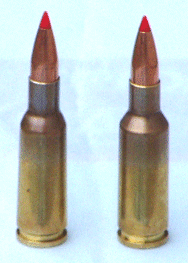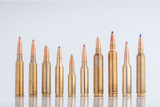6mm PPC for Single Shots
6mm PPC for Single Shot Rifles
Bench Rest Accuracy Made Easy for Sport Shooters
An article by Eben Brown, ©copyright 2004 All Rights Reserved
You don't have to be a "Bench Rest Competitor" to enjoy shooting one of
the most accurate centerfire cartridges in the world... 6mm PPC! With
no complicated brass forming or finicky reloading processes, you can be
shooting near ½ inch groups right from the start and hone your skills to
near ¼ inch groups by your second outing... at least that's how it
worked or me... and I'm NOT a good bench rest shooter!
Why am I making a special case for Single Shot Rifles?
Well, 6mm PPC is a "Short, Fat Cartridge" and those type are generally
believed to produce more bolt thrust than long and skinny cartridges.
Not having the camming leverage of a bolt action, the typical single
shot will lock-up with a too-hot load that may still function in a bolt
gun. But the truth is, too much bolt thrust isn't good for accuracy in
ANY rifle... Single shots just let you know when it's happening sooner
so you can make adjustments in your loads.
The Cartridge: 6mm PPC -
Developed by Louis Palmisano and Ferris Pindell, it has reportedly won
more bench rest accuracy competitions than any other cartridge. Easily
made from Lapua 220 Russian brass, the 6mm PPC has a small primer and uniquely small flash hole that is
credited for much of its inherent accuracy. The "short, fat" shape and
nearly straight body contribute to efficient, consistent powder burning
and stable chamber performance (it grips the chamber well during
ignition).
The Test Rifle: Brown Model 97D - Developed from the EABCO "BF" falling block silhouette pistols that have dominated world championships and set 500 meter distance records. The M97D falling block slides perpendicularly and closes the breech with
absolutely zero camming leverage. This makes it a perfect test bed for
the chamber performance needed for hand loading most other single shot
rifles accurately. This rifle was outfitted with a Swift 8-32x50mm Premier riflescope and Harris Bipod.
Making 6mm PPC Cartridges -
Full length size, prime, charge with powder, and seat a bullet...
sounds like what you do with any other cartridge, doesn't it? In fact,
the only difference with 6mm PPC is that it has to be fired once (fire
formed) to expand to it's final shape and size. But even the
fire-forming shots produce exceptional accuracy. I shot several 3/4"
groups while fire forming at 100 yards, with my best group at nearly
1/2"... so the time spent fire forming was wonderful!
Back at the
reloading bench, I set to working up a load with the now fully shaped
6mm PPC brass. I full length sized, trimmed, and primed each case the
same as I would with any other cartridge... and began loading. With the
resultant load, I easily shot a 5 shot ¼" group... Which is a personal
best for me.

Loading for Best Chamber Performance -
In the P.O. Ackley Handbook (Vol I), there's a chapter on "Pressure"
that dramatically illustrates the proper chamber performance of a
cartridge. Ackley unscrewed a barrel one turn and fired the cartridge in
a dry chamber. The cartridge head stayed flush with the barrel breech
and did not drive backward into the bolt! This is the type of chamber
performance that you want for the lowest amount of stress on your action
and that consequently results in the best potential for accuracy.
In the Brown Model 97D rifle you can check chamber performance easily:
After firing a shot, see if you can press the block downward with only
your thumb on the top of the block. If it moves freely, you've got good
chamber performance. I use three pressure indicators when developing
loads on the Model 97D. First I check the block with my thumb. Then I
check to see if the cartridge sticks at all when ejecting. And finally, I
check the primer for the excessive flattening that would indicate too
much pressure. Generally, the hottest load that still allows the gun to
open and eject freely ends up being my most accurate shooting load...
Which tends to confirm the chamber performance approach to accuracy in
handloading.
Chamber Preparation -
Best chamber performance happens when a cartridge grips the chamber and
does not drive backward significantly. When you want something to grip
(rather than slip), you want to make sure there is no lubricant on the
gripping surfaces. Case forming lube and gun oil are the two lubricants
you want to remove. Clean your 6mm PPC cases after sizing (I wipe mine
with a paper towel and Windex). Clean your chamber with a chamber sized
jag and patch wetted with acetone. (Note: protect your chamber with a
thin coat of USP Oil when you're not out shooting.)
Powder Selection -
I've found that my maximum single shot loads reach the same level of
performance as bolt gun loads when I use one level slower burning powder
type and proper chamber preparation. For example, when the VihtaVuori loading guide shows a maximum with V-133, my best single shot load ends
up being with the slower burning V-135. Here's the simplest way to
proceed: Use a starting load from the loading guide and increase the
powder charge until you detect some resistance to block movement with
your thumb. Next, charge a case with that same amount of powder, tap it
to settle, and look to see if the case is full to the base of the neck.
If its not full, step up to the next slower powder and repeat the load
development process. There's a powder burn rate chart for all brands of
powder in the front of the VihtaVuori 2004 Loading Guide.
When you have the maximum load that will fill the case and still allow
the Model 97D single shot to open and eject freely after firing, you're
ready to shoot some groups!
Bench Resting from a Bipod -
I'm a sport shooter, not a benchrest competitor. And, I freely admit to
not being very good at bench rest shooting. What has worked well for me
is shooting from a Harris SL model bipod
while supporting the buttstock with a sandbag. To keep the rubber bipod
legs from jumping around on the rough plywood shooting bench, I rest
them on something slippery and smooth... a file folder with wax paper
under each bipod leg. You can see my shooting set-up in the top right M97D photograph.
Choosing a Scope for Shooting Groups - It stands to reason that you can't shoot any more accurately than you can see. The Swift 8-32x50mm Premier scope I used here has several features that contribute to super
accurate aiming. First, the full zoom of 32X magnification lets me see
well enough to read the numbers on the Shoot N-C targets. And at 32X the Swift scope reticle only covers up 1/8 inch of target at
100 yards. So, I was able to aim with 1/8" precision from one shot to
the next. Finally, the adjustable objective lens let me dial out any
parallax error so that the repositioning of my eye behind the scope from
one shot to the next did not change the aiming point.
Quirks of the EABCO 6mm PPC Chamber - We dimensioned our 6mm PPC chamber reamer to cut a chamber that fits Lapua 220 Russian brass closely without neck turning. Naturally we recommend you use the Lapua brass for best results.
Reloading Dies for the EABCO 6mm PPC Chamber -
We recommend full length sizing with the Redding 6mm PPC-USA sizer die. Seat
bullets with the Redding 6mm PPC-USA seater die (These come in Redding Die Set #722-80319). Use the Redding #12 Shell holder. Use Redding water soluble case lube for sizing.
Conclusions of a Single Shot Sport Shooter - I love 6mm PPC! It was easy to hand load and it was easy to get excellent results from. The groups shot on this page were with the 65gr bullet and a rifling twist of 1:10. I usually recommend a 1:12 twist and the 58 grain bullet because customers have reported superb accuracy (better groups than I can shoot). But the 5 shot ¼" group I shot with this set-up is my personal best ever... so naturally I'm thrilled!
Recent Posts
-
6.5mm Cartridge Comparison
6.5mm Cartridge Comparison (Pictorial Overview) A Quick Look at Popular 6.5mm Rifle Cartridges Vis …Aug 11th 2025 -
Rethinking Shotgun Slug Accuracy: Why Slower Might Be Better
Last year the Browning slugs I ended up using were a departure from conventional thinking but they …Jun 12th 2025 -
The Timeless Appeal of the .308 Winchester: Why This Cartridge Endures
The .308 Winchester, introduced in 1952, has become one of the most enduring cartridges in firearms …Jul 11th 2024


